我使用了
voronoi_plot_2d 并进行了修改,如下所示。
import numpy as np
import matplotlib.pyplot as plt
from scipy.spatial import Voronoi
from shapely.geometry import Polygon, Point
def angle_between(v0, v1):
return np.math.atan2(np.linalg.det([v0, v1]), np.dot(v0, v1))
def calc_angle(c0, c1, c2):
return angle_between(np.array(c1) - np.array(c0), np.array(c2) - np.array(c1))
def is_convex(polygon):
temp_coords = np.array(polygon.exterior.coords)
temp_coords = np.vstack([temp_coords, temp_coords[1, :]])
for i, (c0, c1, c2) in enumerate(zip(temp_coords, temp_coords[1:], temp_coords[2:])):
if i == 0:
first_angle_crit = calc_angle(c0, c1, c2) > 0
elif (calc_angle(c0, c1, c2) > 0) != first_angle_crit:
return False
return True
def infinite_segments(vor_):
line_segments = []
center = vor_.points.mean(axis=0)
for pointidx, simplex in zip(vor_.ridge_points, vor_.ridge_vertices):
simplex = np.asarray(simplex)
if np.any(simplex < 0):
i = simplex[simplex >= 0][0]
t = vor_.points[pointidx[1]] - vor_.points[pointidx[0]]
t /= np.linalg.norm(t)
n = np.array([-t[1], t[0]])
midpoint = vor_.points[pointidx].mean(axis=0)
direction = np.sign(np.dot(midpoint - center, n)) * n
line_segments.append([(vor_.vertices[i, 0], vor_.vertices[i, 1]),
(direction[0], direction[1])])
return line_segments
class NotConvexException(Exception):
def __str__(self):
return 'The Polygon is not Convex!!!'
class NotAllPointsAreInException(Exception):
def __str__(self):
return 'Not all points are in the polygon!!!'
def intersect(p0, u, q0, q1):
v = (q1 - q0)[np.newaxis].T
A = np.hstack([u, -v])
b = q0 - p0
try:
inv_A = np.linalg.inv(A)
except np.linalg.LinAlgError:
return np.nan, np.nan
return np.dot(inv_A, b)
def _adjust_bounds(ax__, points_):
ptp_bound = points_.ptp(axis=0)
ax__.set_xlim(points_[:, 0].min() - 0.1*ptp_bound[0], points_[:, 0].max() + 0.1*ptp_bound[0])
ax__.set_ylim(points_[:, 1].min() - 0.1*ptp_bound[1], points_[:, 1].max() + 0.1*ptp_bound[1])
def in_polygon(polygon, points_):
return [polygon.contains(Point(x)) for x in points_]
def voronoi_plot_2d_inside_convex_polygon(vor_, polygon, ax__=None, **kw):
from matplotlib.collections import LineCollection
if not all(in_polygon(polygon, vor_.points_)):
raise NotAllPointsAreInException()
if not is_convex(polygon):
raise NotConvexException()
if vor_.points.shape[1] != 2:
raise ValueError("Voronoi diagram is not 2-D")
vor_inside_ind = np.array([i for i, x in enumerate(vor_.vertices) if polygon.contains(Point(x))])
vor_outside_ind = np.array([i for i, x in enumerate(vor_.vertices) if not polygon.contains(Point(x))])
ax__.plot(vor_.points[:, 0], vor_.points[:, 1], '.')
if kw.get('show_vertices', True):
ax__.plot(vor_.vertices[vor_inside_ind, 0], vor_.vertices[vor_inside_ind, 1], 'o')
temp_coords = np.array(polygon.exterior.coords)
line_segments = []
for t0, t1 in zip(temp_coords, temp_coords[1:]):
line_segments.append([t0, t1])
ax__.add_collection(LineCollection(line_segments, colors='b', linestyle='solid'))
line_segments = []
for simplex in vor_.ridge_vertices:
simplex = np.asarray(simplex)
if np.all(simplex >= 0):
if not all(in_polygon(polygon, vor_.vertices[simplex])):
continue
line_segments.append([(x, y) for x, y in vor_.vertices[simplex]])
ax__.add_collection(LineCollection(line_segments, colors='k', linestyle='solid'))
line_segments = infinite_segments(vor_)
from_inside = np.array([x for x in line_segments if polygon.contains(Point(x[0]))])
line_segments = []
for f in from_inside:
for coord0, coord1 in zip(temp_coords, temp_coords[1:]):
s, t = intersect(f[0], f[1][np.newaxis].T, coord0, coord1)
if 0 < t < 1 and s > 0:
line_segments.append([f[0], f[0] + s * f[1]])
break
ax__.add_collection(LineCollection(np.array(line_segments), colors='k', linestyle='dashed'))
line_segments = []
for v_o_ind in vor_outside_ind:
for simplex in vor_.ridge_vertices:
simplex = np.asarray(simplex)
if np.any(simplex < 0):
continue
if np.any(simplex == v_o_ind):
i = simplex[simplex != v_o_ind][0]
for coord0, coord1 in zip(temp_coords, temp_coords[1:]):
s, t = intersect(
vor_.vertices[i],
(vor_.vertices[v_o_ind] - vor_.vertices[i])[np.newaxis].T,
coord0,
coord1
)
if 0 < t < 1 and 0 < s < 1:
line_segments.append([
vor_.vertices[i],
vor_.vertices[i] + s * (vor_.vertices[v_o_ind] - vor_.vertices[i])
])
break
ax__.add_collection(LineCollection(np.array(line_segments), colors='r', linestyle='dashed'))
_adjust_bounds(ax__, temp_coords)
return ax__.figure
points = np.array([[0.1, -0.4], [0, 1.5], [0, 2.25], [1, 0], [1, 1], [1, 2],
[2, 0], [2.5, 1], [2, 2], [2.3, 2.3], [-0.5, -1.3], [-1.5, 3]])
global_boundaries = Polygon([[-5, -2], [3.4, -2], [4.7, 4], [2.7, 5.7], [-1, 4]])
fig = plt.figure()
ax = fig.add_subplot(111)
vor = Voronoi(points)
voronoi_plot_2d_inside_convex_polygon(vor, global_boundaries, ax_=ax)
plt.show()
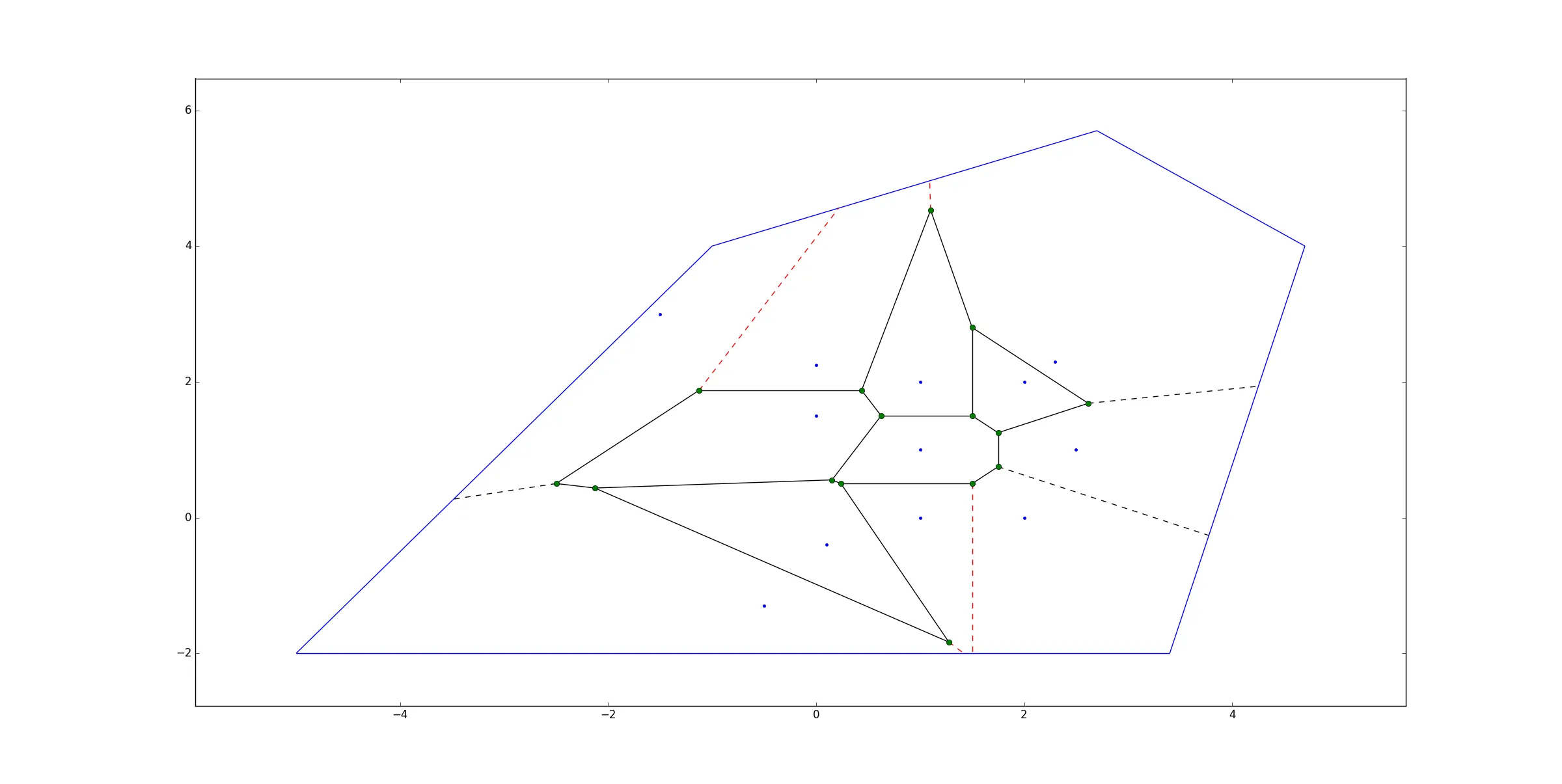
注意:
- 多边形必须是凸的。
- 所有的点都必须在多边形内。
颜色说明:
- 原始点为蓝色。
- Voronoi顶点为绿色。
- 有限内部Voronoi边缘为实线黑色。
- 有限外部Voronoi边缘为虚线红色。
- 无限Voronoi边缘为虚线黑色。
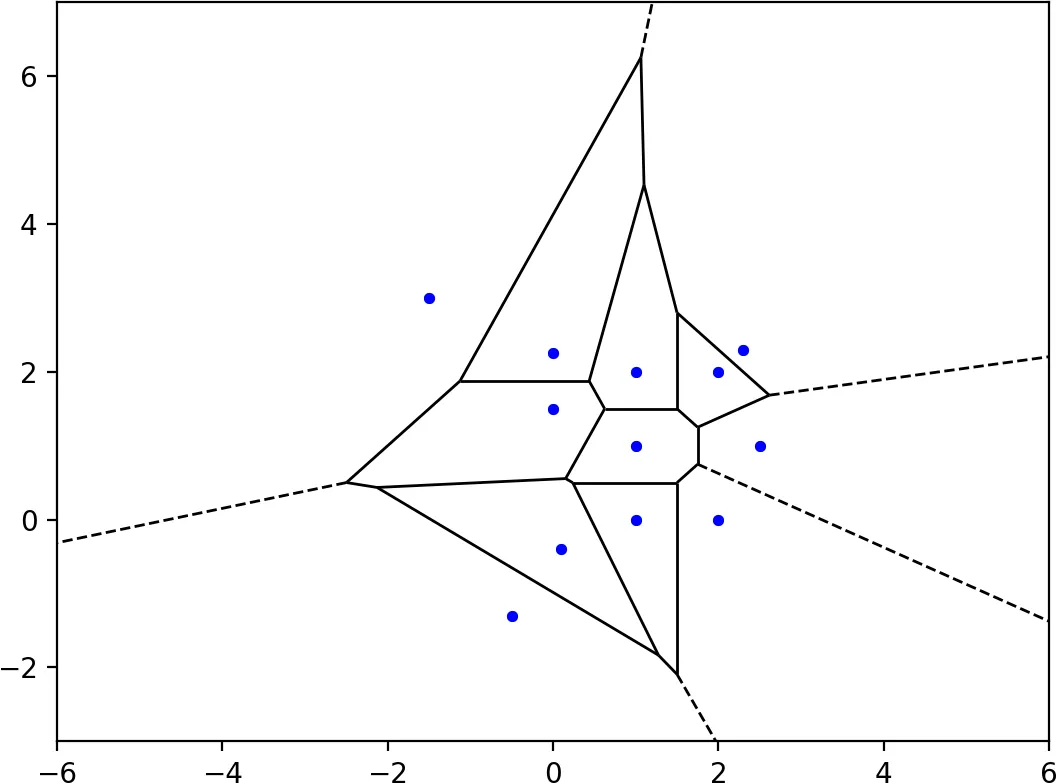
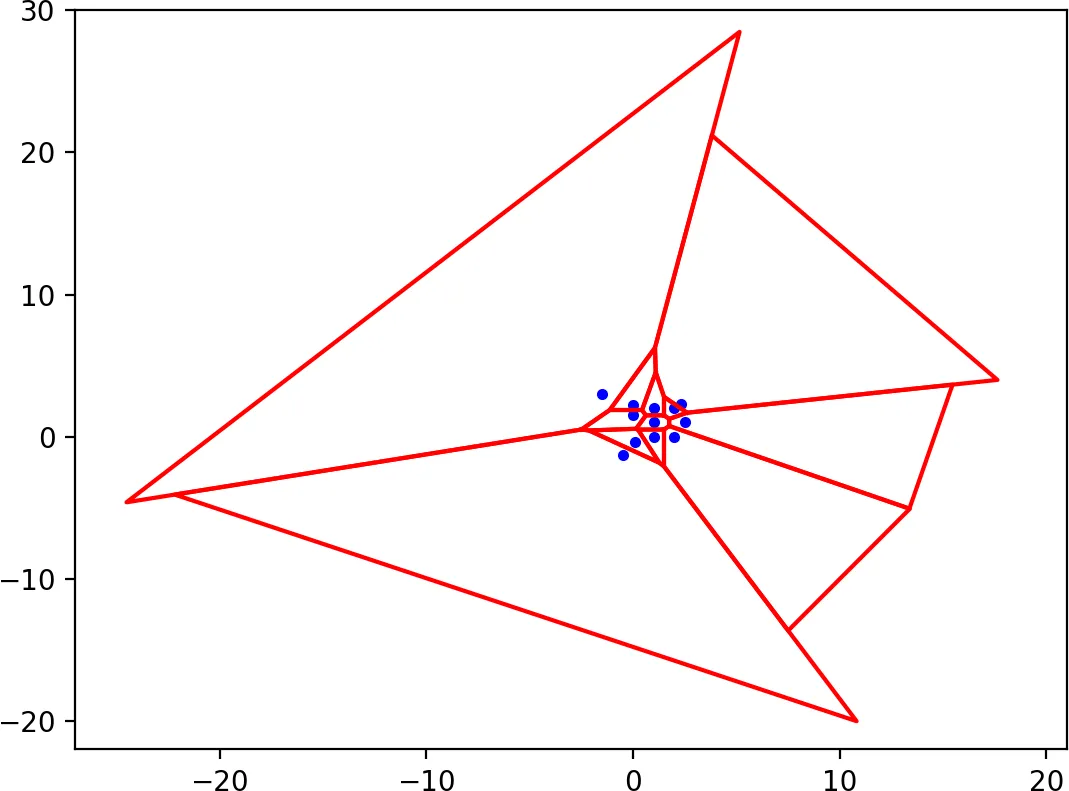
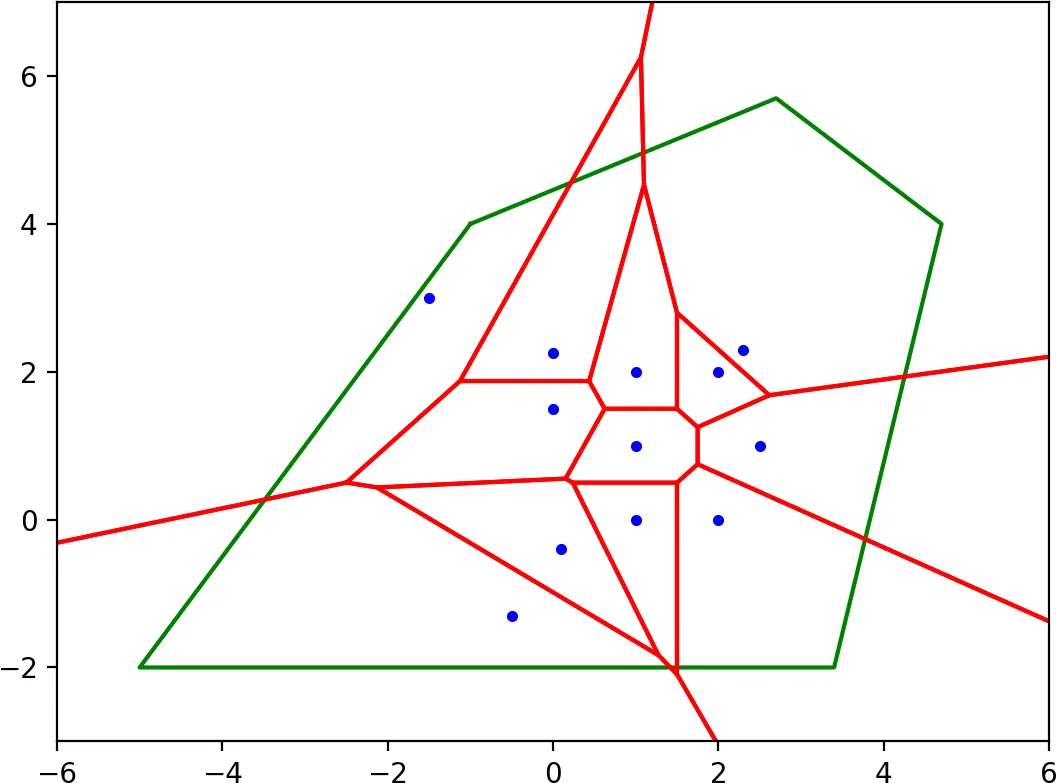
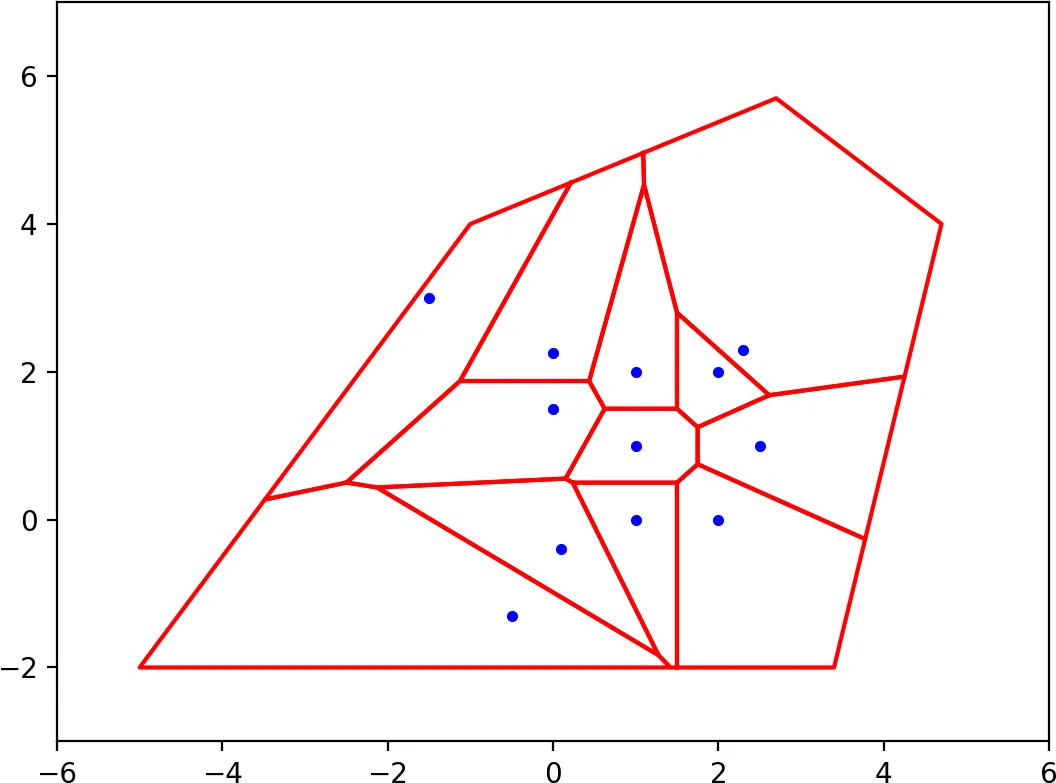

points = [[0, 6000042], [5, 6000060], [8, 6000076], [14, 6000016], [30, 6000069], [39, 6000000]]; boundary = [[-1, 5999999], [40, 5999999], [40, 6000077], [-1, 6000077], [-1, 5999999]]失败了。它在dir_j, dir_k = ridge_direction[i, j]处引发了ValueError: need more than 0 values to unpack。你有什么想法吗?然而,通过shift = points.min(axis=0); points -= shift; boundary -= shift将点和边界向原点移动,确实使它再次工作。这可能是为什么呢? - anttikooy值接近于-1,我一直在想这是否会导致-1无限值的问题:ridge_direction[i, j]=[array([-0.08074507, -0.99673479])]- Arkeen